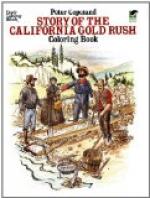For two or three years surveyors and explorers tried to find the easiest way to build this great overland road. Several railroad acts or bills were passed by Congress, and the California Legislature gave the United States the right of way for a road to join the two oceans.
The first railway in the state was opened in ’56 from Sacramento to Folsom, a distance of twenty-two miles. This was built by T.D. Judah, an engineer who had thought and studied a great deal about the overland road so much needed to bring mail and passengers quickly from East to West.
A railroad convention, made up of men from the Pacific states and territories, was held in San Francisco in ’59, with General John Bidwell, a pathfinder of early days, as the chairman. Here Mr. Judah gave such a clear and full account of the central way he had planned, that the convention sent him to Washington, D.C., to see the President, and to try to get Congress to pass a Pacific Railroad Bill. He had very little help in the East, but at last four men of Sacramento, Leland Stanford, C.P. Huntington, Mark Hopkins, and Charles Crocker, took an interest in Judah’s plans, and in ’61 the Central Pacific Railroad Company was formed. Mr. Judah went back to the mountains and studied the pines in summer and the winter snowbanks, to make sure of the easiest grades and the shortest and best way for the track-layers. He found that to follow the Truckee River from near Lake Donner to the Humboldt Desert, would mean the least work. The tunnels would be through rock, and he believed that snow might easily be kept off the track with a snow-plough.
His report pleased the company, and they sent him again to present the case at Washington. In ’62 President Lincoln signed an act or bill to allow the Union and Central Pacific companies to build a railroad and a telegraph line from the Missouri River to the Pacific. In California the land for fifteen miles on each side of the way laid out was given to the railroad company, and two years was allowed them to build the first hundred miles of track.
Ground was broken for the Central Pacific the next year in Sacramento, and Governor Stanford dug up the first shovelful of earth. Then the work went steadily on, but it was hard to raise money. Stanford and his company carried the line forward as fast as possible. More land-grants were given, which doubled the company’s holdings, and in ’65 the road was fifty-five miles past Sacramento and had climbed over much difficult work.




